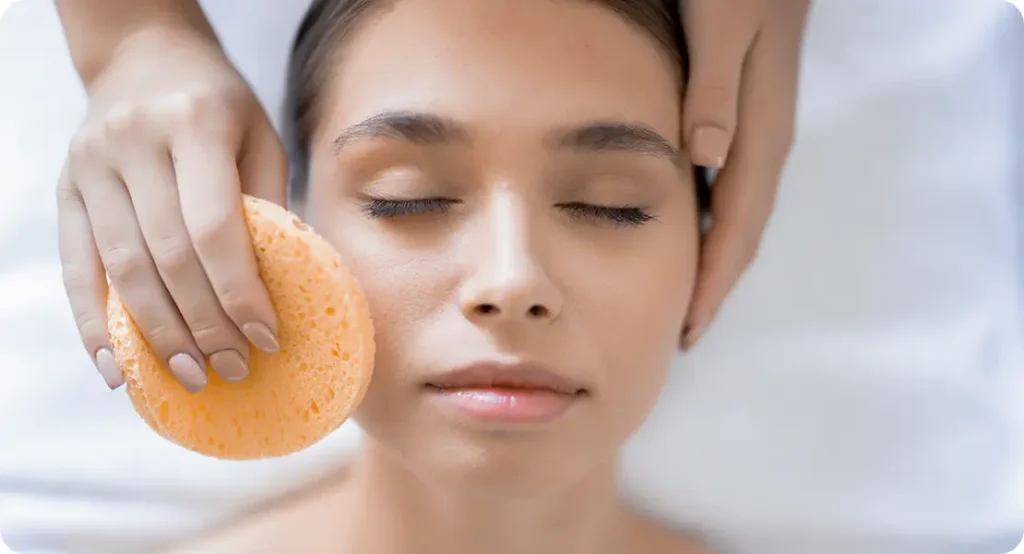Winter Doesn’t Have to Mean Dry, Irritated Skin
As temperatures drop, the air becomes drier, and indoor heating kicks in, your skin often ends up caught in the middle battling dryness, flakiness, tightness, and even unexpected breakouts. You might notice your usual skincare routine just doesn’t seem to cut it anymore. That’s because cold weather, harsh winds, and reduced humidity levels all work together to strip away your skin’s natural moisture barrier. And when that barrier is compromised, irritation and inflammation can creep in quickly.
Even people who don’t normally struggle with sensitive skin may start to see changes in texture, dullness, or increased redness during winter months. It’s not just uncomfortable it can impact your confidence and make your skin feel unpredictable.
But here’s the good news: winter skin woes aren’t something you have to just accept. With the right adjustments and a little extra care, you can protect your skin and maintain a healthy, radiant glow throughout the colder months. No drastic changes or expensive products required just smart, dermatologist-approved tweaks that address your skin’s seasonal needs.
In this article, I’ll walk you through practical, evidence-based tips that can truly make a difference. From upgrading your moisturiser to adjusting your cleansing habits, these simple strategies will help you stay one step ahead of the cold and give your skin the support it needs.
1. Switch to a Gentle, Hydrating Cleanser
Your lightweight, foaming cleanser may have worked wonders during summer, but in winter, it can leave your skin feeling tight, dry, and uncomfortable. That’s because many foaming cleansers contain surfactants that strip away not only dirt and oil but also your skin’s essential moisture barrier.
Instead, opt for a gentle, creamy, or hydrating cleanser specifically formulated for dry or sensitive skin. These cleansers are designed to clean without disrupting your skin’s natural balance.
- Look for moisture-boosting ingredients like glycerin, hyaluronic acid, or ceramides. These help attract and retain water in the skin, even as you cleanse.
- Avoid cleansers with alcohol, artificial fragrances, or strong exfoliants, which can worsen dryness and irritation in colder months.
- Use lukewarm water not hot when washing your face. Hot water can further strip away your skin’s protective oils and leave it more vulnerable to winter dryness.
Making this simple swap can set the tone for a more effective and skin-friendly winter routine.
2. Layer Moisture Like a Pro
When it comes to winter skincare, simply applying one thick cream isn’t always enough especially if your skin is feeling tight, flaky, or extra sensitive. Just like you layer clothes to stay warm, layering skincare products helps seal in hydration and protect your skin from the harsh environment.
Start light and build up in layers, allowing each product to do its job before moving on to the next. This technique ensures deeper absorption and longer-lasting moisture.
- Begin with a hydrating toner or essence. These water-light formulas prep your skin and provide an initial boost of hydration that helps subsequent products absorb more effectively.
- Follow up with a serum ideally one containing hyaluronic acid, niacinamide, or vitamin B5. These ingredients attract moisture and strengthen your skin’s barrier.
- Seal it in with a rich moisturiser. Look for products with ceramides, shea butter, or squalane to lock in all the hydration and keep your skin soft and plump.
- Add a facial oil if your skin is especially dry or prone to dehydration. Oils help create a protective seal over your skin, preventing water loss throughout the day or night.
- Apply products to slightly damp skin to enhance absorption and effectiveness.
Layering not only hydrates more deeply but also helps protect your skin from winter’s drying effects leaving you with a supple, nourished complexion.
3. Add an Occlusive Barrier
If you’re layering moisturisers but still waking up with tight, flaky skin, you might be missing one crucial step: an occlusive barrier. Occlusives are the final layer in your skincare routine that physically seal in moisture and prevent water from evaporating from the surface of your skin a process known as transepidermal water loss (TEWL). This is especially important in winter, when dry air and indoor heating can dehydrate your skin fast.
Adding an occlusive helps your skin retain all the hydration you’ve layered underneath, making your skincare routine more effective particularly overnight when your skin naturally loses more moisture.
- Look for occlusive ingredients like petrolatum (found in products like Vaseline), lanolin, beeswax, or mineral oil. These form a protective layer on top of your skin.
- Use a “slugging” technique a light layer of an occlusive balm or ointment over your moisturiser before bed. It helps lock in moisture and supports overnight repair.
- Target dry zones such as around the nose, mouth, or cheeks if you’re prone to combination skin and don’t want to apply occlusives all over your face.
- Go for non-comedogenic formulas if you’re acne-prone. There are occlusive options that won’t clog pores, like dimethicone or specific non-pore-clogging balm formulations.
This final step can make a noticeable difference in how your skin feels by morning smoother, more hydrated, and less irritated.
4. Adjust Your Exfoliation

Exfoliation is essential for keeping your skin smooth and helping products absorb better but in winter, too much of it can do more harm than good. Cold weather already compromises your skin’s barrier, so over-exfoliating can lead to dryness, flaking, redness, and even micro-tears in the skin.
The goal during winter is to exfoliate smarter, not harder. Gentle, occasional exfoliation helps remove dead skin cells without stripping away essential moisture.
- Reduce exfoliation to once or twice a week, especially if your skin is feeling sensitive, tight, or inflamed. Your skin needs more recovery time during colder months.
- Choose gentler exfoliating acids, such as lactic acid or mandelic acid. These are milder AHAs that hydrate as they exfoliate and are less likely to irritate.
- Avoid physical scrubs with harsh particles like walnut shells or sugar granules, which can cause micro-damage to dry, delicate winter skin.
- Follow exfoliation with a rich moisturiser or hydrating serum to soothe and replenish the skin barrier right after exfoliating.
- Listen to your skin if it stings, looks red, or feels extra sensitive, you may need to take a break from exfoliants altogether for a few days.
A gentle approach ensures that exfoliation supports your winter skincare routine rather than sabotaging it.
5. Invest in a Humidifier
One of the most overlooked causes of winter skin dryness isn’t what you put on your skin it’s the air around you. Indoor heating systems strip humidity from the environment, creating dry conditions that pull moisture from your skin. The result? Tightness, flaking, and irritation, no matter how much moisturiser you apply.
That’s where a humidifier comes in. By restoring moisture to the air, it helps your skin stay hydrated and balanced all day and night.
- Place a humidifier in your bedroom or workspace, especially where you spend long hours or sleep. This ensures your skin stays in a moisture-rich environment for extended periods.
- Look for cool-mist or ultrasonic models that are quiet and energy-efficient great for overnight use without disrupting your sleep.
- Aim for an indoor humidity level of 40–60%, which is ideal for both skin health and respiratory comfort.
- Use distilled or filtered water in your humidifier to prevent mineral build-up and bacteria growth.
- Clean it regularly to keep it hygienic and functioning properly dirty humidifiers can spread mould or allergens, which can irritate the skin and lungs.
A humidifier is one of the simplest home upgrades that can have a powerful impact on your winter skincare results.
6. SPF Is Still Non-Negotiable
It might be cloudy, cold, or even snowing but that doesn’t mean you can skip sunscreen. UV rays penetrate clouds and glass, and they’re still strong enough to damage your skin in winter. In fact, snow can reflect UV rays, increasing your exposure even more.
Sun protection isn’t just for summer holidays or beach days. It’s a year-round essential if you want to protect your skin from premature ageing, dark spots, and even skin cancer.
- Always apply a broad-spectrum sunscreen with SPF 30 or higher, even on overcast days or when you’re indoors but near windows.
- Look for formulas with added moisturising ingredients, like hyaluronic acid or ceramides, to prevent your skin from drying out while staying protected.
- Apply it as the final step in your morning skincare routine, after moisturiser and before makeup don’t forget areas like your neck, ears, and hands.
- Reapply every 2–3 hours if you’re spending time outdoors, especially if you’re doing winter sports or walking in direct sunlight.
SPF is your daily shield against invisible damage, and it’s just as important in December as it is in July.
7. Eat and Drink for Your Skin

Winter skincare isn’t just about what you put on your skin it’s also about how you nourish it from within. When it’s cold, we often drink less water and crave more comfort food, which can leave our skin dull, dry, or prone to breakouts. But your diet plays a major role in maintaining a strong, healthy skin barrier.
By staying hydrated and including skin-friendly nutrients in your meals, you’re giving your skin the building blocks it needs to stay soft, resilient, and glowing even in freezing weather.
- Drink plenty of water throughout the day, even if you don’t feel thirsty. Herbal teas and warm lemon water also count toward your hydration.
- Eat foods rich in omega-3 fatty acids, such as salmon, flaxseeds, chia seeds, and walnuts. These healthy fats help strengthen your skin’s natural lipid barrier.
- Include antioxidant-rich foods like berries, leafy greens, and colourful vegetables. They help fight inflammation and protect skin cells from oxidative stress.
- Avoid excessive caffeine and alcohol, which can dehydrate your body and worsen dryness or sensitivity.
Think of your winter skin routine as an inside-out approach what you eat and drink can be just as powerful as your moisturiser.
8. Look for Barrier-Repair Ingredients
Winter weather can leave your skin barrier compromised leading to dryness, redness, and heightened sensitivity. The key to restoring balance lies in choosing skincare products that support and repair your skin’s natural protective layer.
Instead of layering on just any moisturiser, reach for ingredients that actively help rebuild your barrier and soothe irritation at the same time.
- Ceramides are lipids (fats) that occur naturally in your skin. When included in moisturisers or serums, they help seal in moisture and prevent environmental damage.
- Niacinamide (Vitamin B3) calms inflammation, reduces redness, and boosts hydration. It’s also great for improving skin texture and strengthening the barrier over time.
- Colloidal oatmeal has anti-inflammatory and moisturising properties. It forms a protective film on the skin and helps relieve itching, irritation, and roughness especially helpful for conditions like eczema or winter rashes.
- Look for fragrance-free, hypoallergenic formulas to minimise the risk of further irritation, especially if your skin is already feeling raw or reactive.
Adding these ingredients to your winter routine can make all the difference in keeping your skin calm, supple, and resilient.
9. Dress for the Weather

Your skincare routine doesn’t end at the bathroom mirror what you wear matters too, especially when cold air and icy winds are constantly battling your skin’s defences. Proper clothing can help protect exposed skin from moisture loss and irritation, keeping it healthier throughout the winter months.
But be strategic some fabrics can do more harm than good if they rub or irritate sensitive skin.
- Wear scarves, gloves, and hats to shield your skin from windburn and cold air. These areas are particularly vulnerable and often the first to show signs of dryness.
- Opt for soft, breathable materials like cotton or bamboo for base layers. These help reduce friction and prevent itchiness or rashes caused by rougher fabrics.
- Avoid direct contact with wool or synthetic fibres, which can irritate dry, sensitive, or eczema-prone skin. If you must wear them, add a cotton layer underneath to act as a barrier.
- Wash winter accessories regularly, as sweat and dirt buildup can clog pores or trigger breakouts especially around the jawline, neck, and forehead where scarves and hats rub.
Dressing smart helps your skin stay protected when the weather is anything but gentle.
10. Know When to Seek Help
Even with the best winter skincare routine, sometimes your skin needs more than just over-the-counter solutions. Persistent or worsening symptoms can signal an underlying condition that needs professional attention.
Don’t wait for things to get unbearable early intervention can prevent complications and lead to faster relief.
- Watch for signs like severe redness, cracking, or bleeding, which may indicate conditions such as eczema, psoriasis, or allergic dermatitis that need medical treatment.
- If your skin becomes increasingly itchy, inflamed, or painful, it’s a good idea to speak with a dermatologist. These symptoms may not improve with home care alone.
- Chronic flare-ups or rashes that don’t respond to moisturisers or barrier creams are often a red flag that prescription medication might be needed.
- A dermatologist can provide a tailored diagnosis and recommend effective treatments, from medicated creams to lifestyle adjustments, to restore your skin’s health.
Knowing when to seek help is just as important as knowing how to care for your skin day-to-day.
Final Thoughts: Don’t Let Winter Dull Your Glow
Your skin faces new challenges every season, and winter is no exception. With the right products, techniques, and lifestyle tweaks, you can keep your skin resilient and comfortable all winter long.
If you’re struggling with winter skin issues or need help adjusting your routine, you can get in touch with us to book a consultation with one of our expert dermatologists. Personalised care can make all the difference.
References:
- Jin, Y., Wang, F., Payne, S.R. & Weller, R.B., 2021. A comparison of the effect of indoor thermal and humidity condition on young and older adults’ comfort and skin condition in winter. Indoor and Built Environment, 30(1), pp.112–126. Available at: https://journals.sagepub.com/doi/full/10.1177/1420326X211030998
- Fujimoto, A., Nakagawa, N., Iwasaki, T., Moriwaki, S., Takema, Y. & Imokawa, G., 2013. Effects of water nanodroplets on skin moisture and viscoelasticity. Skin Research and Technology, 21(2), pp.207–213. Available at: https://onlinelibrary.wiley.com/doi/full/10.1111/srt.12195
- Tempark, T., Shem, A. & Lueangarun, S., 2024. Efficacy of ceramides and niacinamide-containing moisturizer versus hydrophilic cream in combination with topical anti‑acne treatment in mild to moderate acne vulgaris: a split-face, double-blinded, randomized controlled trial. Journal of Cosmetic Dermatology. https://doi.org/10.1111/jocd.16212
- Healthline, 2022. Humidifiers: what they do for health, uses, types, and more. Healthline, updated 15 Nov. https://www.healthline.com/health/humidifiers-and-health
- PubMed, 2016. The impact of air humidity in healthy and diseased states. PubMed. https://pubmed.ncbi.nlm.nih.gov/27306376/
